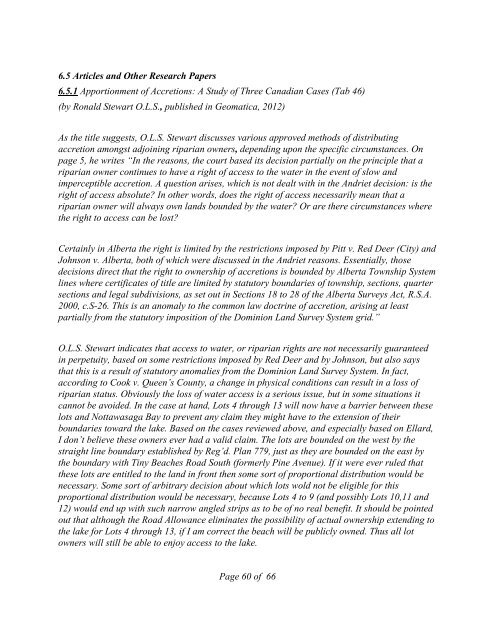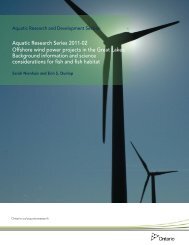Report of Research, Field Investigation and Survey of Robert D ...
Report of Research, Field Investigation and Survey of Robert D ...
Report of Research, Field Investigation and Survey of Robert D ...
Create successful ePaper yourself
Turn your PDF publications into a flip-book with our unique Google optimized e-Paper software.
6.5 Articles <strong>and</strong> Other <strong>Research</strong> Papers<br />
6.5.1 Apportionment <strong>of</strong> Accretions: A Study <strong>of</strong> Three Canadian Cases (Tab 46)<br />
(by Ronald Stewart O.L.S., published in Geomatica, 2012)<br />
As the title suggests, O.L.S. Stewart discusses various approved methods <strong>of</strong> distributing<br />
accretion amongst adjoining riparian owners, depending upon the specific circumstances. On<br />
page 5, he writes “In the reasons, the court based its decision partially on the principle that a<br />
riparian owner continues to have a right <strong>of</strong> access to the water in the event <strong>of</strong> slow <strong>and</strong><br />
imperceptible accretion. A question arises, which is not dealt with in the Andriet decision: is the<br />
right <strong>of</strong> access absolute? In other words, does the right <strong>of</strong> access necessarily mean that a<br />
riparian owner will always own l<strong>and</strong>s bounded by the water? Or are there circumstances where<br />
the right to access can be lost?<br />
Certainly in Alberta the right is limited by the restrictions imposed by Pitt v. Red Deer (City) <strong>and</strong><br />
Johnson v. Alberta, both <strong>of</strong> which were discussed in the Andriet reasons. Essentially, those<br />
decisions direct that the right to ownership <strong>of</strong> accretions is bounded by Alberta Township System<br />
lines where certificates <strong>of</strong> title are limited by statutory boundaries <strong>of</strong> township, sections, quarter<br />
sections <strong>and</strong> legal subdivisions, as set out in Sections 18 to 28 <strong>of</strong> the Alberta <strong>Survey</strong>s Act, R.S.A.<br />
2000, c.S-26. This is an anomaly to the common law doctrine <strong>of</strong> accretion, arising at least<br />
partially from the statutory imposition <strong>of</strong> the Dominion L<strong>and</strong> <strong>Survey</strong> System grid.”<br />
O.L.S. Stewart indicates that access to water, or riparian rights are not necessarily guaranteed<br />
in perpetuity, based on some restrictions imposed by Red Deer <strong>and</strong> by Johnson, but also says<br />
that this is a result <strong>of</strong> statutory anomalies from the Dominion L<strong>and</strong> <strong>Survey</strong> System. In fact,<br />
according to Cook v. Queen’s County, a change in physical conditions can result in a loss <strong>of</strong><br />
riparian status. Obviously the loss <strong>of</strong> water access is a serious issue, but in some situations it<br />
cannot be avoided. In the case at h<strong>and</strong>, Lots 4 through 13 will now have a barrier between these<br />
lots <strong>and</strong> Nottawasaga Bay to prevent any claim they might have to the extension <strong>of</strong> their<br />
boundaries toward the lake. Based on the cases reviewed above, <strong>and</strong> especially based on Ellard,<br />
I don’t believe these owners ever had a valid claim. The lots are bounded on the west by the<br />
straight line boundary established by Reg’d. Plan 779, just as they are bounded on the east by<br />
the boundary with Tiny Beaches Road South (formerly Pine Avenue). If it were ever ruled that<br />
these lots are entitled to the l<strong>and</strong> in front then some sort <strong>of</strong> proportional distribution would be<br />
necessary. Some sort <strong>of</strong> arbitrary decision about which lots wold not be eligible for this<br />
proportional distribution would be necessary, because Lots 4 to 9 (<strong>and</strong> possibly Lots 10,11 <strong>and</strong><br />
12) would end up with such narrow angled strips as to be <strong>of</strong> no real benefit. It should be pointed<br />
out that although the Road Allowance eliminates the possibility <strong>of</strong> actual ownership extending to<br />
the lake for Lots 4 through 13, if I am correct the beach will be publicly owned. Thus all lot<br />
owners will still be able to enjoy access to the lake.<br />
Page 60 <strong>of</strong> 66
















